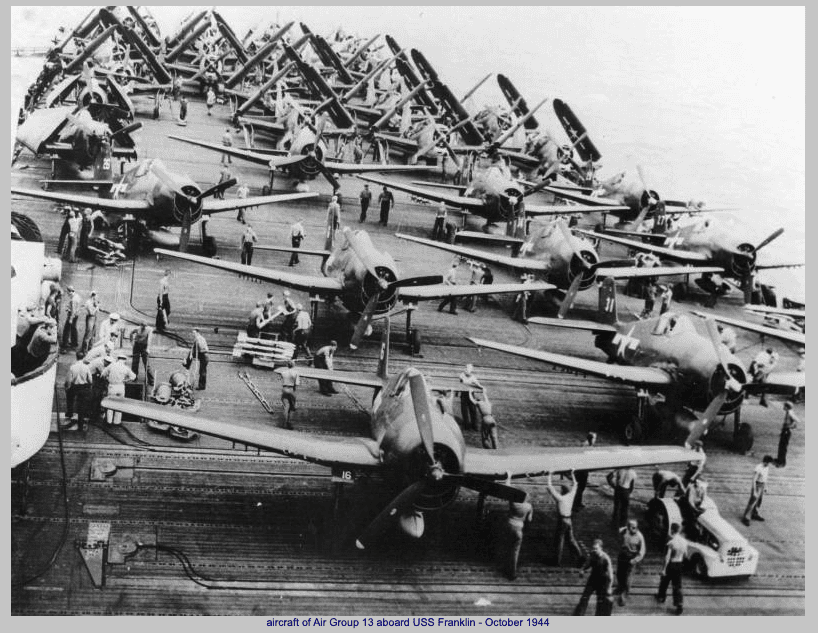USS Franklin Draws Its First Blood–July 4, 1944

On 30 June TG 58.2 sortied from Eniwetok at 0730. On this mission, Franklin joined Wasp (CV-18) and the light carriers Monterey (CVL-26) and Cabot (CVL-28). The carriers were accompanied by the heavy cruisers Boston (CA 69), Canberra (CA70), and the light cruiser San Juan (CL54), which joined them later. There were nine destroyers along as well. Their orders were to destroy enemy aircraft and facilities at Japanese bases on Iwo Jima, Haha Jima, and Chichi Jima before resuming operation in the Marianas. TG 58.2 was commanded by Rear Admiral Ralph Davison, who had assumed command three days earlier. He flew his flag from Wasp. Later that day, TG 58.1, commanded by Rear Admiral J.J. “Jocko” Clark, also sortied.
The first two days saw …intensive gunnery and flight training exercises using all weapons, including simulated group air attacks…1
Training was suspended on 3 July to refuel the destroyers.
The two task groups cruised northwest toward their targets without detection until a Japanese aircraft (Allied code name, “Emily”) spotted them at 1238 on 3 July. The first pilot attempting to shoot down the snooper fired all his ammunition without destroying the aircraft. Several others moved in, making numerous passes, and finally sent the Emily crashing into the sea. Due to the time it took to shoot down the aircraft, the task groups believed they had been detected.
Before the approaching fleet had been spotted, Admiral Clark proposed that his task group launch a fighter sweep against Iwo Jima. Admiral Davison concurred, and pilots in the sweep reported 39 Japanese aircraft confirmed shot down and 15 more as probably destroyed. Additional aircraft were destroyed on the ground. The following morning, at 0415 on 4 July, 86 miles from Iwo Jima, TG 58.2 launched its fighter sweep consisting of 16 F6Fs led by Commander W.M. Coleman
Five strikes throughout the day followed. (Aircraft from Wasp and Cabot also participated). Another strike was launched against shipping, spotted by T.G. search planes. That afternoon, Franklin launched a strike against Haha Jima. The TG 58.2 strikes comprised 152 fighters, 85 torpedo planes, and 102 bombers.2
At midday, BOSTON, CANBERRA, MILLER, AND THE SULLIVANS left the disposition to join with cruisers and destroyers of Task Group 58.1 for the bombardment of Iwo Jima. The bombardment commenced at 1501 and was completed at 1638.3
Air Group Thirteen’s Action Report stated that
F6F-5 appeared to outrun and out-dive ZEKE at all altitudes. However, F6F-5 could not turn inside of ZEKE. ZEKES hit by .50 caliber did not readily burn or explode. (Zeke is the Japanese fighter’s code name, better known as the Mitsubishi A6M Zero.)4*
VF-13s First Use of Rockets
This was not only the air group’s first combat but also the Hellcat pilots’ first use of five-inch rockets. While rockets may be appropriate for the Fourth of July, the performance that day was nothing to celebrate. In his endorsement of the Air Group’s Action Report, Commander C. C. Howerton wrote
…a total of 600 five-inch H.E. (high explosive) Rockets were loaded on F6Fs. One hundred and fourteen (114) of these rockets failed to fire in combat over the target due to faulty electrical circuits and pilots accidentally pushing down guards over the master switch on rocket arming panel. Steps are being taken to remedy these faults.5
Still, the Task Group Action Report stated that rocket fighters are very effective against light shipping and buildings. The report noted that the rocket fighter is the best aerial weapon against land batteries of A.A. guns. (Rockets were more successfully used in a strike two days later on Guam with fourteen of fifteen planes placing their rockets on the designated targets6 Whatever solutions Commander Howerton implemented worked well.)
By 1900, all planes had returned to their respective carriers.
Franklin’s crew and Air Group Thirteen were now combat veterans. But the fighting wasn’t over. July would prove a busy month for Franklin and Air Group Thirteen. On 6-22 July, she attacked Rota, Guam, and other islands in the Marianas. On 25-27 July, she struck the Palau Islands, Yap, and Ulithi.
*Readers of WWII history will note that this report contradicts most reports about Zekes or Zeros. This may have been due to inaccurate fire by pilots in their first combat, but that is only speculation on my part.
Did you arrive here via a search engine? I am the author of the forthcoming book Heroes By The Hundreds: The Story of the USS Franklin (CV-13). In addition to writing about the bravery of the crews that saved her, I will discuss the lessons we can learn in leadership and decision-making and the changes the US Navy made because of those lessons.
Feel free to follow me on Facebook. There, I am M. Glenn Ross, Author. I also write a monthly newsletter, Glenn’s Action Report, about subjects I find interesting in my research. You can sign up for it below. Feel free to leave a comment or ask a question. Thanks for reading.
-Glenn
Footnotes
- USS Franklin (CV13) and Air Group Thirteen Special Action Report dated 9 July 1944 p 5
- Action Report Task Group 58.2 Strike on Iwo Jima and Haha Jima on 4 July 1944 dated 14 July 1944 p 6
- Action Report Task Group 58.2 p 6
- Air Group Thirteen Action Report p 6
- Air Group Thirteen Action Report p 16
- Air Group Action Report p 64